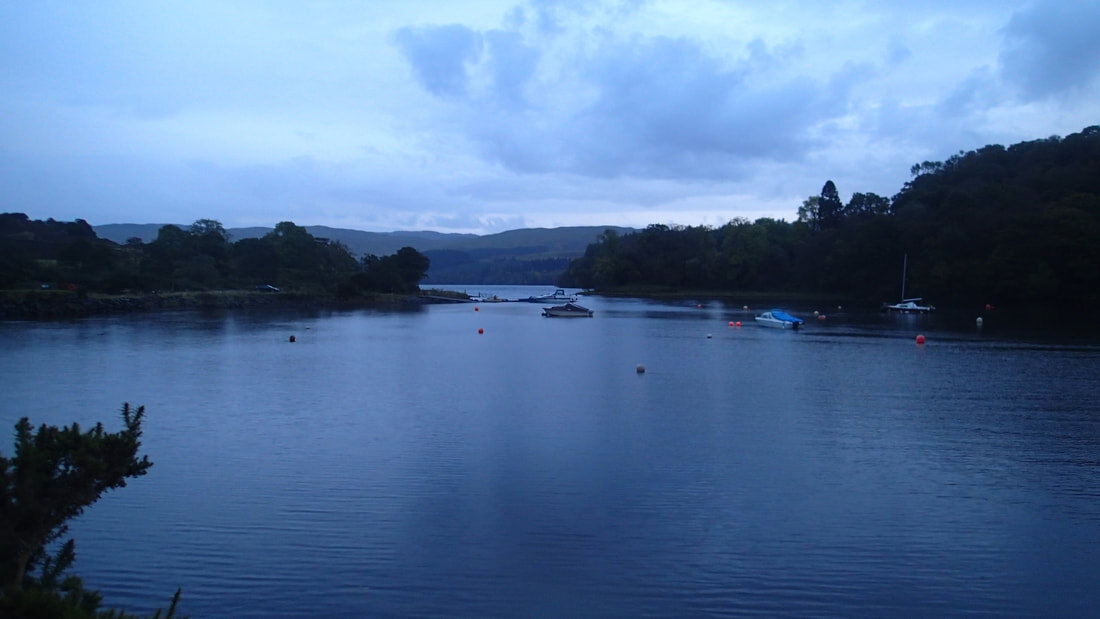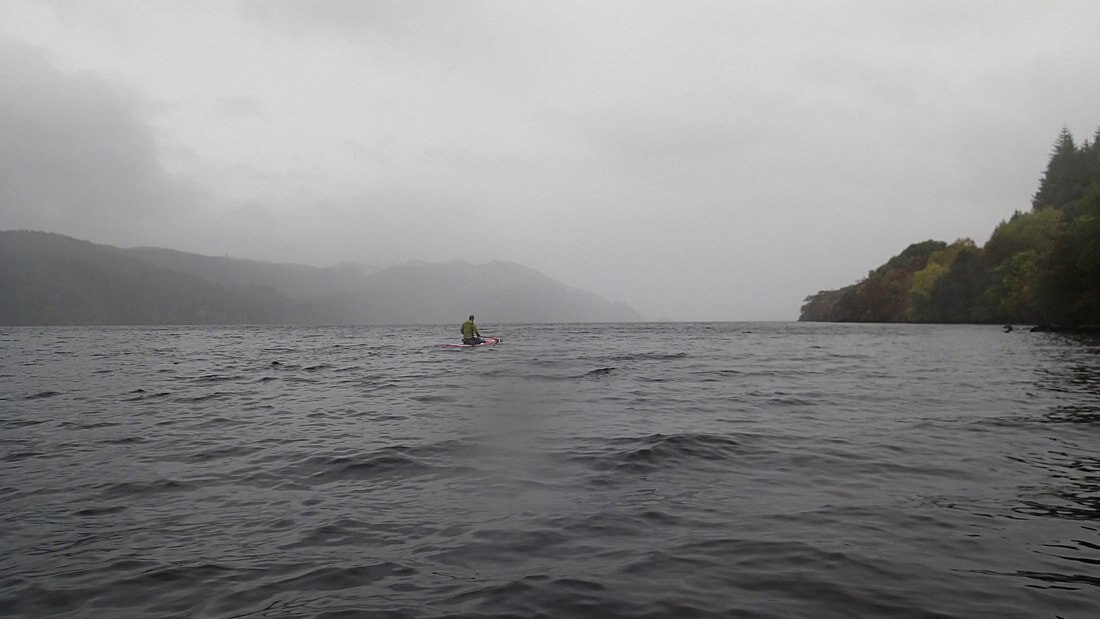RACE AGAINST MARIA
Words By: Marcus Samperi Photography By: Neil Froggitt
The weather had been far from perfect with high winds on Bala Lake [Wales]; torrential, driving rain on Lake Windermere [England] and the forecast deteriorating on Loch Awe [Scotland] as each hour passed by. This wasn’t just the usual unpredictable post-summer British weather; there was something in the offing – a Category 4 Hurricane was on its way. Hurricane Maria had already wrecked havoc on the Caribbean Islands leaving 55 dead and many more injured. It was now following a route straight across the Atlantic Ocean towards the British Isles and, in particular, Scotland. The Argyll and Bute County, home to Loch Awe, was within its anticipated path. Meteorologists were predicting that the hurricane would be downgraded to a storm before it hit land but still had warnings of winds gusting up to 90mph. With Loch Awe measuring 25 miles (41km) tip-to-tip and only 0.65 miles (1km) wide it has a reputation for catching the prevailing westerly winds. With few natural barriers blocking the route, it can create an uninterrupted ‘wind tunnel’. The loch is notorious for being deceptively deep and cold, plunging to depths of 307 feet (93.6 metres) in places with temperatures close to freezing particularly at this time of the year [October]. Falling into the loch at these temperatures has been known to cause paralysis of the muscles that can lead to drowning. The dangers were very real and the mood amongst the team was mixed. Our only way of completing the challenge: to SUP the length of the 3 longest lakes in the 3 countries that make up mainland UK in 3 days, was to start as early as possible and be off the loch before Storm Maria arrives. This was now turning into a race against the weather.
The next morning and after an uncomfortably short sleep we donned our still-damp SUP gear and headed to the nearest mooring point at Ford Bay [An Lodan] filled with trepidation. We knew Loch Awe would be tough under normal conditions but with the added pressure of a storm approaching tensions were running high. We had prepared well: studied the weather forecasts, the route and had radio contact between us. We were also broadcasting our GPS tracker live to the web primarily for our supporters to follow our progress but secondarily to act as a safety measure to pinpoint where we were in case of emergency. We had food, an emergency shelter and extra clothes in case we became stranded or fell in. Now all we had to do was begin; and, at first light we cast off onto Britain’s longest lake.
It was eerily calm; we were gliding effortlessly over the waters surface, weaving past moored up pleasure boats as we headed towards Loch Awe. The immediate horizon was draped in an early morning dark blue hue with a layer of grey clouds above. The question wasn’t if it would rain but when and for how long. A feeling of stillness filled the air and with it the previous stresses started to diminish: this was it. All too soon we joined the main body of the loch and, with that, the calmness and gliding disappeared introducing us to a head-on northerly wind, kicking up a swell that would push us backwards if we stopped paddling, even for a second. Thankfully, we knew that these northerly winds would eventually swing round to a south westerly direction, giving us free speed later on. But would we progress far enough through the loch to benefit before Storm Maria was forecast to hit? We had to try regardless.
Loch Awe rests in a valley surrounded by lush vegetation. The west bank had a steep gradient towering high above us in parts. Every inch lined with trees, the leaves radiating a rich green breaking up the greyness of the day. In my mind, it would create the perfect protective canopy for the ground underneath. During the most intense downpours, I would imagine myself hunkered down, snuggled up in a dry sleeping bag, cradling a hot chocolate whilst looking out over the sheer expanse of the loch. Together with the soundtrack of the swaying trees above and the waves crashing below gave a truly hypnotic daydream. Snapping back into reality, I was actually still battling the elements, making slow progress and feeling that the Gods were conspiring against us.
Thankfully, the early morning weather forecast was beginning to come into affect; the wind was shifting to a south westerly and the free speed it provided was phenomenal! However, we were now becoming acutely aware of what the locals referred to as: ‘the wind tunnel’. Not only did the wind drastically intensify it was creating an almighty swell on the surface of the water creating regular peaks and troughs; the peaks were gaining height and were large enough that, if caught, would propel the SUP forwards and at quite a rate. On the flip side, the troughs were becoming deeper meaning: should the peak be missed then the board would follow the trajectory of ‘the wave’ nose-diving into the loch, rescued only by stamping on the rear bringing the nose-tip back above the waterline avoiding full submersion or, worst still, being catapulted off the board and into the freezing water. This was more like SUP surfing then conventional paddle boarding. Far from being daunting, it was adding to the enjoyment. A huge smile appeared across my face. It felt like we were paddling in a grade of rapids, the noise being created really enforced this illusion: the crashing waves, the howling wind, the torrential rain splashing into the water. I could hardly hear my own power grunts as I aimed to hit every peak; it was so loud. There was no way a conversation could be had or heard. The concentration that was needed meant that there was no time to take stock and think, which in hindsight was a blessing. As the day progressed the sky felt like it was closing in, the clouds were becoming noticeably thicker and a mist was dropping, slowly encroaching the highest treetops. This was really pushing our SUP skills to the limit and it was reminding us that Storm Maria was getting closer.
SUP surfing the swell was both physically and mentally exhausting, particularly when returning to the water after a food stop. Paddling into the breakers was a whole different experience and one more akin to surfing rather than paddle boarding especially around the mouth of the River Awe, a tributary linking Loch Awe and Loch Etive. The trick was to crouch low on the board, creating ballast and stability, and to hit the breaker at a slight angle. We found that should the board hit a breaker nose-first then, depending on the strength and size of the wave, the board lifted skywards risking a full bow-to-stern capsize unless we redistributed our weight to counteract it. The speed and velocity of the breakers was such that it was an almighty battle with the wind and swell to regain the position that we had before the break, was it worth the effort to stop?
It was getting late in the day, the conditions were on the verge of exceeding a tipping point: how much more battering by the elements could we fight against? We were exhausted, aching, soaked through: when do you make that decision to admit defeat and call an end to proceedings? Had we pushed our luck too much? These questions were firmly etched onto our minds. But with a stroke of luck as we battled our way past the Island of Innis Chonain and away from the mouth of the River Awe, the rain broke, the wind slowed and on the horizon, through the ever descending mist, was what looked like a castle: was that Kilcurn Castle, the final landmark before the end? Were we on the home run?
It was and we were; this was the final push and didn’t our bodies feel it. We continued pushing hard through the aches and tiredness, the castle getting closer and closer until it towered above us. Our end point was a tiny car park to the rear but getting there meant navigating around the shallow waters, scraping our fins along the rocky gradient leading up to the shore. We had made it; we had conquered Loch Awe and won. With that, we had successfully paddled the 3 longest lakes in Wales, England and Scotland.
Storm Maria did arrive two hours later and, as predicted, brought winds that would have ended our journey. The decision to begin at first light proved to be correct and paved our way to victory. The journey was not just an endurance challenge but an almighty battle against the elements. With it brought some of the most exhilarating hours of stand up paddle boarding we have ever experienced to date.






